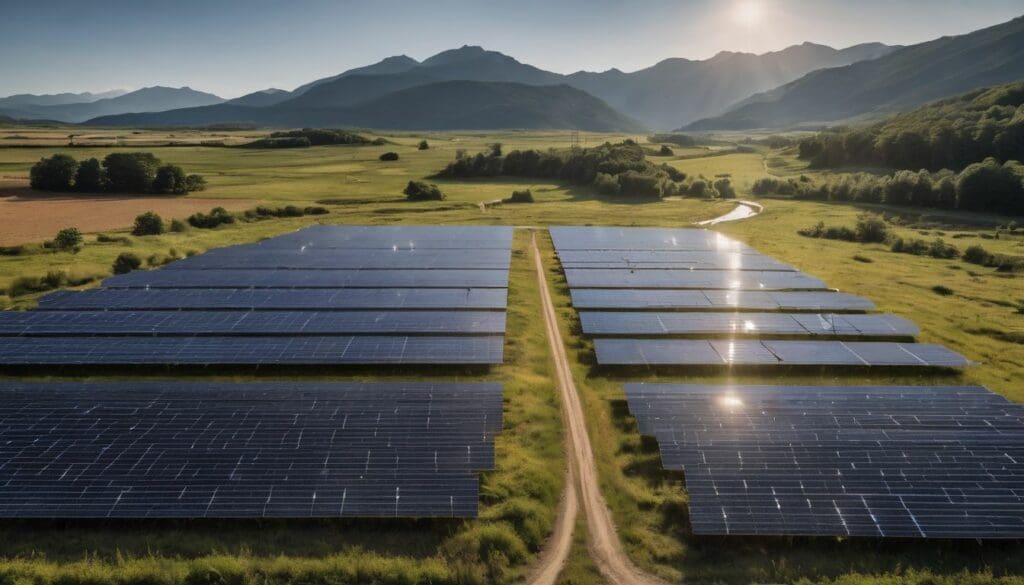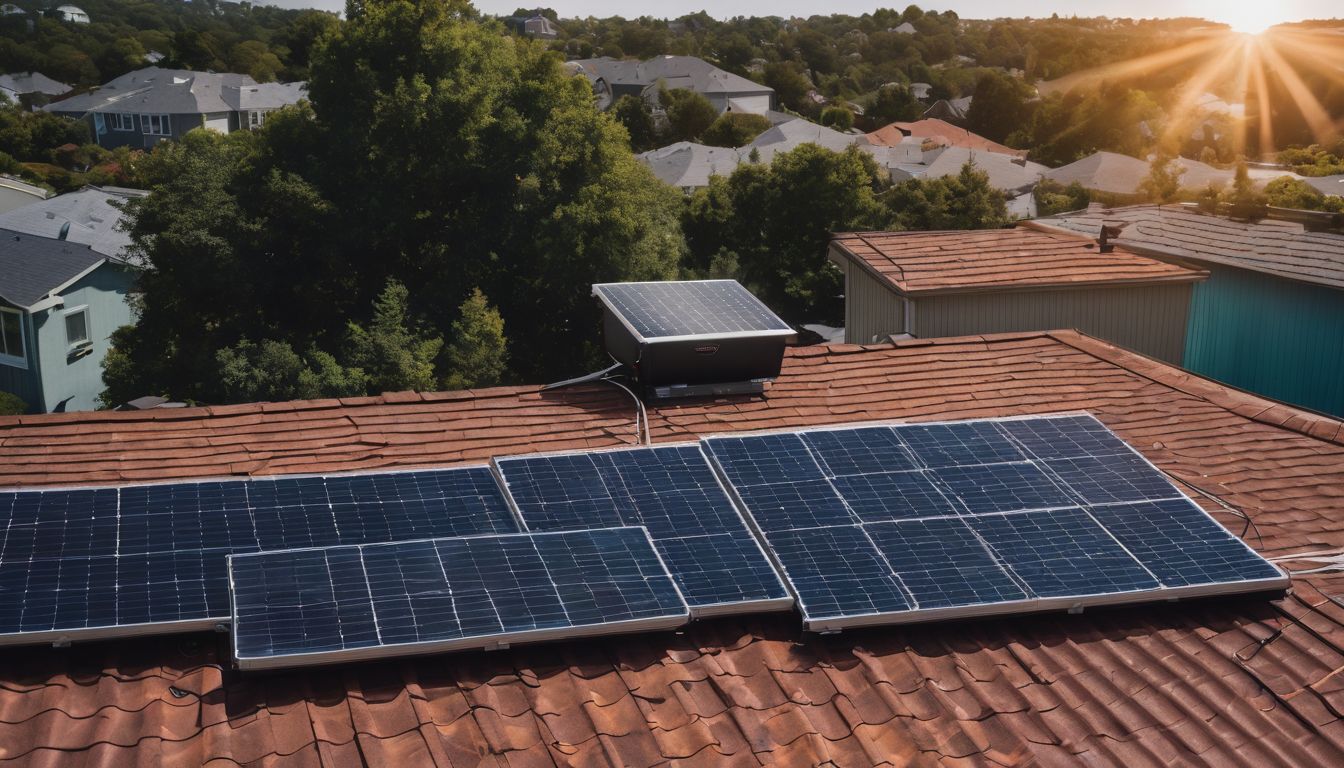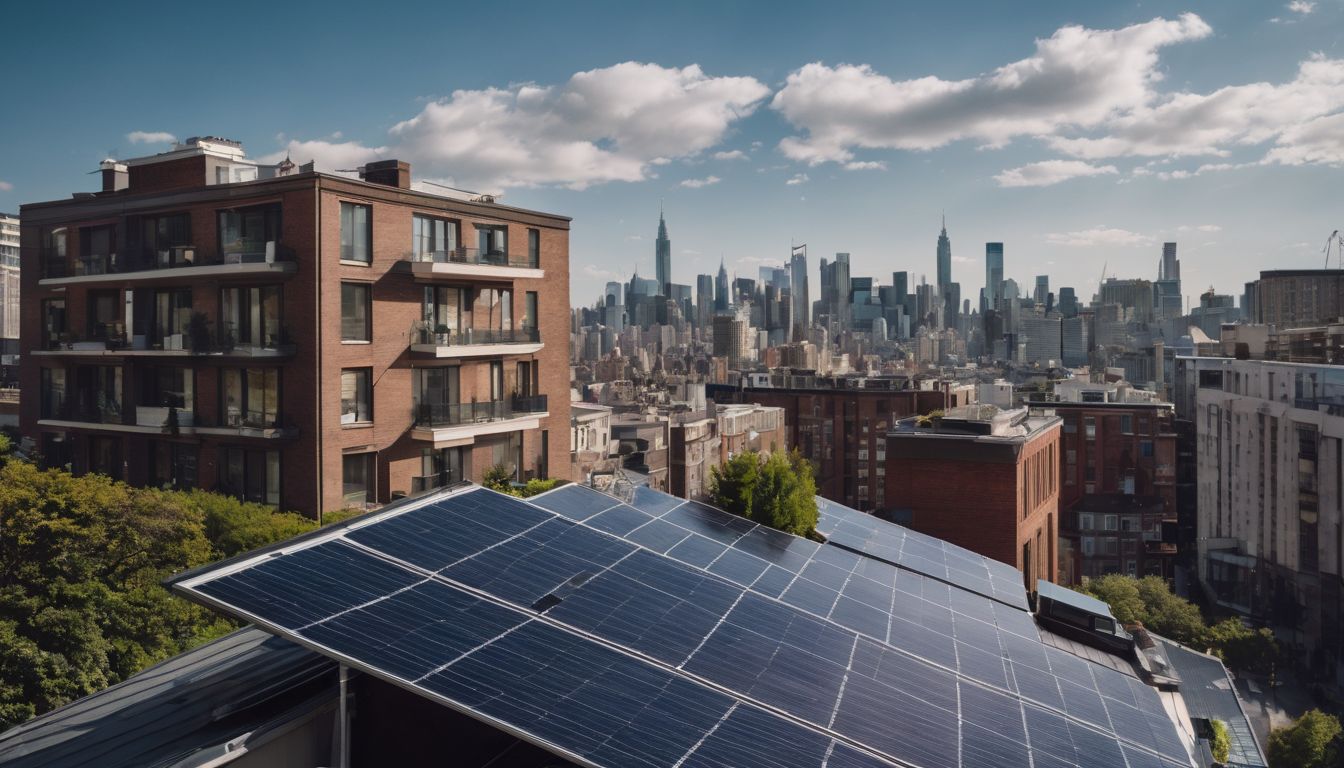Solar farms shine as a beacon of clean energy, but they also cast a shadow on our natural world. They sprawl across vast lands, potentially disrupting fragile ecosystems and wildlife.
In this post, we’ll delve into the environmental impacts of solar farms and explore ways to harness their benefits while minimising harm. Get ready to uncover the sunny and shaded sides of solar power!
Key Takeaways
- Solar farms require significant land use which can lead to habitat loss and ecosystem disruption, but innovative solutions like agrivoltaics can help balance energy production with conservation efforts.
- Water usage for maintaining solar panels is an environmental concern; however, adopting efficient cleaning methods and using alternative water sources such as rainwater can reduce impacts.
- The disposal of solar panel waste needs careful management due to hazardous materials inside them, making recycling crucial to prevent soil and water contamination.
- While solar energy reduces greenhouse gas emissions significantly, it does have limitations including dependency on weather conditions and initial high costs offset by long-term savings.
- Comparing renewable energy forms shows that each has its own benefits and trade – offs. Sustainable practices in the development of renewables like solar are key for a greener future.
Environmental Impacts of Solar Farms
Solar farms have various environmental impacts, including land and water use, habitat loss, ecosystem disruption, exposure to hazardous materials, and the generation of solar panel waste.
It is important to consider these effects when expanding the use of solar energy.
Land use
Solar farms need large areas of land to capture the sun’s energy effectively. This can lead to transforming green fields or even forests into rows of solar panels, an action that has direct consequences on local ecosystems and wildlife habitats.
Careful planning is necessary to ensure that we balance our renewable energy portfolio with conservation goals.
Choosing locations for new solar installations demands a thoughtful look at how it affects the surrounding environment. Developers must work alongside environmental experts to minimise habitat loss and disruption to the ecosystem.
With responsible land management and innovative designs like agrivoltaics, which combines agriculture with solar farming, we can aim for sustainable development in our quest for cleaner energy sources.
Next, let’s consider another vital resource: water use associated with solar farms.
Water use
Solar farms require water for cleaning and maintenance of solar panels. The water is used to remove dirt, dust, and other debris that can obstruct sunlight from reaching the panels, ensuring maximum efficiency.
This usage of water is an important consideration as it impacts the overall environmental sustainability of solar energy production. Implementing efficient cleaning methods and exploring alternative sources such as rainwater harvesting or using recycled water can significantly reduce the impact on local water resources.
Maximising hydrological benefits in solar farm operations involves adopting sustainable practices to minimise water use and prioritise conservation efforts in line with environmental concerns.
By reducing reliance on freshwater sources, solar farms can contribute positively to ecological balance and long-term conservation goals.
Habitat loss
Solar farms can lead to habitat loss for various wildlife species, disrupting their natural environments. The construction and maintenance of solar facilities often involve clearing large areas of land, impacting the local flora and fauna.
This loss of habitat can result in a decrease in biodiversity and alter the balance within ecosystems, affecting delicate food chains and natural processes essential for environmental stability.
The expansion of solar farms into pristine habitats may displace native species, leading to population declines or even extinction in extreme cases. Additionally, the altered landscape can fragment habitats, isolating populations and hindering migration patterns crucial for sustaining healthy wildlife populations.
Ecosystem disruption
The loss of natural habitats and the extensive use of land for solar farms disrupt ecosystems. Local flora and fauna are displaced, affecting biodiversity and ecological balance. Solar farms can fragment habitats, isolating species from food sources and breeding grounds, impacting wildlife populations.
Solar energy generation impacts not only the immediate vicinity but also adjacent areas as well. This disruption requires careful consideration to minimise adverse effects on the environment while harnessing clean, renewable energy sources effectively.
Exposure to hazardous materials
Solar farms can lead to exposure to hazardous materials such as cadmium and lead, which are used in the production of solar panels. As a result, there is a potential risk of contamination to soil and water sources if these materials are not properly managed.
It is essential for solar farm operators to follow strict guidelines regarding the handling and disposal of these hazardous substances to prevent environmental contamination. Regular monitoring and maintenance are necessary to ensure that these materials do not pose a threat to the surrounding ecosystem.
Moreover, measures should be implemented during the manufacturing, installation, operation, and decommissioning stages of solar farms to minimise the risk of exposure to hazardous materials.
Solar panel waste
Improper disposal of solar panels can lead to environmental contamination. When not disposed of correctly, the hazardous materials in solar panels can leach into the soil and water, harming wildlife and ecosystems.
The recycling and proper management of solar panel waste are crucial to prevent long-term environmental damage.
End-of-life management for solar panels is essential to reduce their impact on the environment. Proper disposal methods help minimise waste and ensure that valuable resources are reused or recycled, contributing to a more sustainable energy landscape.
Harmful emissions
Solar farms produce harmful emissions, such as sulfur dioxide and nitrogen oxides, which contribute to air pollution and have negative impacts on human health. These emissions are released during the manufacturing process of solar panels and the transportation of materials.
Reduction in harmful emissions is crucial for the environment’s well-being, making it essential for solar farms to adopt eco-friendly practices.
Prioritising sustainable production methods can significantly reduce harmful emissions associated with solar energy. Ensuring that solar panel manufacturers adhere to stringent environmental standards will mitigate the adverse effects of these emissions on both local ecosystems and global climate change initiatives.
Maximising Hydrological and Environmental Benefits of Solar Farms
Prioritising sustainable practices can help minimise land and water use, reduce harmful emissions, and ensure proper disposal of solar panels. Read on to discover how solar energy compares to other forms of renewable energy.
The importance of renewable energy
Renewable energy is crucial for reducing our carbon footprint and mitigating the environmental effects of traditional energy sources. Embracing solar power and other forms of renewable energy can significantly lower greenhouse gas emissions, preserving biodiversity and safeguarding ecosystems.
It offers a sustainable solution to our energy needs while minimising harmful impacts on nature. By prioritising green technology, we can work towards a cleaner, more environmentally friendly future.
Maximising hydrological and environmental benefits of solar farms contributes to conserving our planet’s resources through reduced land and water use. Proper disposal of solar panels ensures minimal ecological impact, promoting alternative energy sources that prioritise sustainability over harmful emissions.
Reducing carbon footprint
Solar farms play a crucial role in reducing carbon footprint by generating clean, renewable energy that produces minimal greenhouse gas emissions. By prioritising sustainable practices and minimising land and water use, solar farms contribute to the conservation of natural resources and help mitigate the environmental impact of traditional energy sources.
Proper disposal of solar panels and reducing harmful emissions further enhance their positive influence on the ecosystem. Embracing solar energy not only promotes biodiversity conservation but also fosters a healthier planet for future generations.
Integrating solar power into our energy mix is an effective way to reduce reliance on fossil fuels, thereby decreasing carbon emissions and combating climate change. This shift towards cleaner energy sources offers substantial environmental benefits while supporting the transition to a more sustainable future.
Prioritising sustainable practices
Incorporating sustainable practices in solar farms reduces their environmental impact, safeguarding nature and wildlife. Emphasising renewable energy sources like solar power minimises reliance on fossil fuels, cutting down carbon emissions significantly.
Implementing eco-friendly strategies such as reducing land and water use further enhances the positive influence of solar energy on the environment. Proper disposal of solar panels ensures minimal ecological consequences, promoting a more sustainable approach to harnessing clean energy.
Prioritising sustainable practices within solar farms provides an opportunity for protecting ecosystems and wildlife while mitigating harmful effects on the environment. By embracing responsible land and water use, minimising harmful emissions, and ensuring proper disposal of materials, the ecological implications of solar farms can be drastically reduced.
Minimising land and water use
To minimise land and water use, solar farms are designed to maximise energy production within a smaller footprint. This is achieved by incorporating innovative technologies such as dual-use agriculture, where the land beneath solar panels can be used for growing crops or raising livestock simultaneously.
Additionally, advanced irrigation systems reduce water consumption for cleaning and maintaining the panels, ensuring efficient use of resources.
Prioritising sustainable practices in solar farm development helps to minimise environmental impact while meeting energy demands. By implementing land-efficient designs and water-saving techniques, we can harness the power of solar energy without compromising precious natural resources.
Proper disposal of solar panels
Proper disposal of solar panels is crucial for reducing environmental impact. When solar panels reach the end of their lifespan, it’s important to dispose of them responsibly to prevent harmful materials from leaching into the soil and waterways.
Disposing of solar panels in designated recycling facilities helps recover valuable materials like silicon and glass, reducing the need for raw materials and energy-intensive manufacturing processes.
Disposal also prevents hazardous substances such as lead, cadmium, and other toxic chemicals from entering the environment. Recycling these components reduces harmful emissions associated with extracting and processing virgin materials, contributing to a cleaner and more sustainable future for our planet.
Reducing harmful emissions
To further advance the eco-friendly practices of solar energy, reducing harmful emissions is crucial. By implementing sustainable manufacturing processes and prioritising clean production techniques, the adverse environmental impact can be minimised.
Moreover, ensuring that solar farms operate efficiently and effectively also contributes to lowering harmful emissions, subsequently benefiting the surrounding ecosystem and wildlife.
In addition to enhancing renewable energy sources like solar power, a reduction in harmful emissions positively impacts air quality and diminishes the overall carbon footprint. This proactive approach aligns with conservation efforts and supports sustainable environmental practices.
Comparing Solar Energy to Other Forms of Renewable Energy
When comparing solar energy to other forms of renewable energy such as wind, hydroelectricity, geothermal, and biomass energy, it is important to consider factors such as cost-effectiveness, environmental impact, and reliability.
Each form of renewable energy has its own set of benefits and limitations that should be carefully considered in order to make informed decisions about sustainable energy sources.
Wind energy
Wind energy offers a sustainable and eco-friendly alternative to traditional fossil fuels. Harnessing the power of the wind, turbines convert kinetic energy into electricity without emitting harmful greenhouse gases.
This renewable energy source minimises our reliance on finite resources while reducing air pollution, making it a vital component in mitigating climate change.
By tapping into the natural force of wind, we can generate significant amounts of clean power to meet our growing energy demands. With ongoing advancements in technology, wind farms have become increasingly efficient and cost-effective, ensuring a brighter and cleaner future for generations to come.
Hydroelectricity
Transitioning from wind energy, another form of renewable energy that has minimal environmental impact is hydroelectricity. Hydroelectric power harnesses the force of flowing water to generate electricity.
This process minimises greenhouse gas emissions and reduces reliance on fossil fuels, contributing to a cleaner environment. By utilising hydropower, we can prioritise sustainable practices while preserving natural habitats and ecosystems.
Hydroelectricity also plays a crucial role in reducing our carbon footprint by providing an alternative to traditional energy sources. This renewable energy source offers us an opportunity to decrease harmful emissions and protect wildlife while meeting our growing energy needs sustainably.
Geothermal energy
Geothermal energy harnesses the natural heat of the Earth to generate electricity. Deep wells are drilled into underground reservoirs of steam or hot water, which is then brought to the surface and used to drive turbines.
This renewable resource produces minimal emissions and provides a consistent source of power, making it an environmentally friendly alternative to traditional fossil fuels. Geothermal energy offers substantial benefits by reducing greenhouse gas emissions and supporting sustainable practices.
Compared to other forms of renewable energy, geothermal energy has a smaller environmental footprint as it requires less land use and has no visual impact on the landscape. It also operates with high efficiency and reliability because it is not dependent on weather conditions like solar or wind power.
Biomass energy
Biomass energy is a renewable energy source that comes from organic materials such as wood, agricultural waste, and food crops. These organic materials are used to generate electricity or produce heat.
When these materials are burned, they release carbon dioxide into the atmosphere; however, this process is considered carbon neutral because the plants used for biomass absorb an equal amount of carbon dioxide during their growth.
Biomass energy has the potential to reduce greenhouse gas emissions and dependence on non-renewable sources like fossil fuels. It also contributes to sustainable practices by utilising organic waste that would otherwise end up in landfills.
Furthermore, biomass energy can promote local economic development by creating jobs in rural areas where feedstocks are abundant. Although it has significant environmental benefits, it’s important to ensure that biomass production does not compete with food production or lead to deforestation.
The Benefits and Limitations of Solar Energy
Solar energy reduces greenhouse gas emissions, but its dependence on weather and maintenance costs may pose limitations. Learn more about the environmental impacts of solar farms and the importance of sustainable practices in renewable energy production.
Reduced greenhouse gas emissions
Solar energy significantly reduces greenhouse gas emissions by cutting down on the dependence of fossil fuels for electricity generation. This decrease in emissions helps combat climate change and reduce air pollution, benefiting both the environment and public health.
By harnessing the power of sunlight to produce electricity, solar energy contributes to a cleaner and more sustainable future while mitigating the environmental impact associated with traditional energy sources.
Reducing greenhouse gas emissions is vital for preserving ecosystems, protecting wildlife habitats, and promoting overall environmental health. Solar farms play a crucial role in this effort by providing a renewable energy source that minimises carbon dioxide and other harmful gases released into the atmosphere.
Dependence on weather
Solar energy’s dependence on weather means that its efficiency can fluctuate based on factors such as cloud cover, rain, and the changing seasons. This variability can impact the consistent generation of electricity from solar farms.
Understanding this factor is crucial for environmental enthusiasts looking to maximise the benefits of solar power while also considering its limitations in providing a stable energy supply.
The weather’s influence highlights the need for complementary energy sources to ensure continuous power availability. By recognising this limitation, environmentally-conscious individuals can make informed decisions about integrating solar power into their sustainable practices, enhancing overall effectiveness in reducing carbon footprint and promoting renewable energy adoption.
Maintenance costs versus long-term savings
Transitioning from the impact of weather dependency, it’s essential to consider maintenance costs versus long-term savings when evaluating the benefits and limitations of solar energy.
Though there are upfront expenses associated with solar panel installation and ongoing maintenance, the long-term financial savings can be substantial. By investing in solar energy, individuals and businesses can significantly reduce their reliance on traditional power sources, leading to lower electricity bills over time.
Furthermore, as solar technology continues to advance, operational and maintenance costs are decreasing while efficiency is increasing.
Conclusion
In conclusion, solar farms have a significant impact on the environment. They can lead to habitat loss and ecosystem disruption but also offer opportunities for ecological benefits.
Maximising the positive effects of solar energy is crucial in reducing harmful emissions and our reliance on non-renewable energy sources. Understanding and managing these impacts will be essential as we transition towards a more sustainable future.
FAQs
1. What effects do solar farms have on the environment?
The environmental effects of solar power, such as from solar farms, include changes to the ecosystem and potentially affecting wildlife habitats.
2. Can solar energy impact nature in negative ways?
Yes, while it’s a clean energy source, the impact of solar farms on nature can include disruptions to land use and local ecological impacts if not properly managed.
3. Are there consequences for ecosystems when we build solar farms?
There are potential consequences of solar farms on ecosystems, like altering soil composition or water flow patterns which can affect plant and animal life.
4. How does installing a solar farm affect animals living nearby?
Impacts of solar energy on wildlife may involve changing their habitat or movement patterns due to the presence of large-scale installations and equipment.





